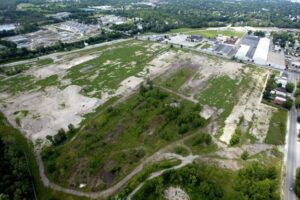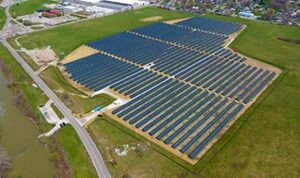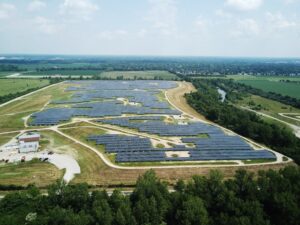This Guest Article for REVITALIZATION is by Doug Kilmer & Paula Lancaster.
With the growth of renewable energy development in the U.S., managing land use conflicts is becoming increasingly challenging. The best and highest use of property varies widely by geography and community, and the placement of renewable energy assets may not be consistent with long term land use planning or local preferences.
Today, we see many instances of friction between energy developers and the local community, particularly with development of agricultural land.
One possible avenue to reduce this friction and ease land use constraints is to transform environmentally distressed properties into renewable energy host sites. Solar on brownfields, also known as brightfields, is already a popular alternative seeing increasing redevelopment activity.
These types of properties/projects can also include battery energy storage systems (BESS), especially on smaller properties in the right electricity markets, and even wind power in some cases. Re-Powering America’s Land (What is RE-Powering | US EPA) is a U.S. Environmental Protection Agency (EPA) initiative aimed at exactly this type of land use.
As leaders in renewable energy consulting, TRC is advancing the brownfields to brightfields approach. Leveraging our expertise in environmental consulting, power generation and electric transmission development, we have gained insights and experience to guide successful solar projects on distressed properties.
Why Brightfields?
Integrating solar PV power generation on brownfields, landfills, and other environmentally distressed properties that don’t have a good option for another productive re-use is potentially transformative. Solar power plants may be the only option for some properties that have extremely limited future use, such as landfills and coal combustion residuals (CCR, also known as coal ash) impoundments.
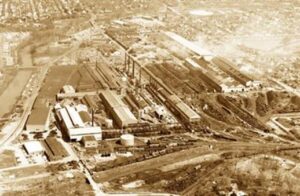
Photo 1. Former Continental Steel main plant site in Kokomo, IN. (Courtesy of Kokomo Perspective The monster that once was | KP | kokomoperspective.com)
Municipalities can take advantage of this approach to not only provide the community with affordable electricity but also to generate property tax on underperforming assets. Long-standing vacant parcels can be brought back into productive use. Additionally, it’s more common to find blighted properties in depressed urban areas.
Repurposing these properties with renewable energy replaces the blight and provides low-cost energy to urban communities helping to address issues of environmental justice. Often urban-based blighted properties provide a sizable property that would otherwise be unaffordable.
An example of this is Kokomo Solar 1 in Kokomo, Indiana. This Superfund Site was formerly a Continental Steel plant that went bankrupt in 1986, was decommissioned in 1988, and then sat vacant until 2016. Years of manufacture of nails, wire and fencing had left the soil and groundwater heavily impacted on this property in the core of Kokomo.
TRC played a key, behind-the-scenes role in making this Superfund-to-solar transformation happen. We developed a Contaminant Containment and Contingency Plan, as well as a plan for how to lay out and construct the thousands of solar panel racks without compromising the surficial direct contact barrier, which is the protective lining that covers the entire site.
TRC advised on site plan review and permit sequencing with local regulatory agencies such as the Indiana Department of Environmental Management (IDEM), addressing the Department’s concerns with construction on a Superfund site. We worked with the developer and the State to design the array and construction methods in accordance with the existing Environmental Restrictive Covenants (ERCs) placed on the site as part of the Superfund activities.
We also provided key services that enabled the project owner to secure the millions of dollars in financing needed to complete the project, including environmental due diligence and the negotiation of a comfort letter with the EPA to provide protection against liability for future cleanup costs of existing residual contamination.
Now the site hosts a 21,000-panel, 7-megawatt solar photovoltaic (PV) power generation plant. The successful development of this new source of renewable energy supports 1,000 homes; and for the first time in decades, what was once home to Kokomo’s largest employer and largest reminder of blight, is once again producing tax revenue for the city.
How a Brownfield Becomes a Brightfield
Brightfields come with an added level of complexity based on the impacted soil and/or groundwater conditions that may be encountered during construction or that could otherwise adversely impact the operation of other reuse solutions for these properties.
Relative to mixed use or residential style redevelopments, solar and BESS typically come with lower hurdles as the renewable energy use has a lesser exposure (i.e., typically no long-term occupation) for human health concerns.
A land redeveloper must account for the added costs of managing a blighted site’s environmental condition, as well as obtaining liability protection that is available through the Comprehensive Environmental Response, Compensation, and Liability Act of 1980 (CERCLA) All Appropriate Inquiry (AAI) or via State programs. Construction residual materials, such as contaminated soil and debris from site preparation, must be managed in accordance with all applicable rules and regulations typical of all brownfields.
Site control to prevent inadvertent exposure to the public is just as important and has its own set of challenges. Particularly when there is no responsible party remaining, such as the responsible manufacturing entity that was dissolved decades earlier. It is vital to understand the degree of contamination, the location of contamination (e.g., will it be encountered within the construction footprint) and liability protection hurdles that can significantly impact the cost to construct brightfields in an industry that is competitive and has thin profit margins.
One of the biggest challenges for brightfields is not just the actual presence of impacted media, but the perceived condition of the property and how to manage it. Uncertainty wrapped around liability and on-going site management and compliance (e.g., consent orders and decrees, restrictive covenants, and activity use limitations) can be stressful for companies.
Developers must also be confident cleanup is complete or at least to a stage that will not disrupt the future operation of the solar power plant. Project proponents will want to make sure the site has been fully closed and be aware of all ongoing remediation, monitoring and testing obligations. There’s also no uniform development plan for all Brownfields. Sites can pose unique challenges based on location (i.e., landlocked vs riverfront) and type and degree of contamination.
However, there are advantages to using environmentally distressed properties. Leasing costs are often lower and land use and natural resource permitting can be simpler, not to mention the electrical infrastructure for interconnection is often available at these abandoned and decommissioned industrial sites.
These blighted properties can be in highly congested urban areas where other land options are either not available or excessively expensive. Brownfields tend to be in populated areas that once hosted industrial facilities, meaning there tends to be an easy connection to the grid compared to rural projects.
In some densely populated Northeastern states where large tracts of land are at a premium, brownfields can be attractive. According to the Environmental Protection Agency, there are more than 310 CCR landfills and 735 CCR ponds in the United States. Some of them are closed and hundreds more will be closing over the next several years, opening an opportunity to site solar facilities on these otherwise underutilized pieces of land.
Landfills to Light Source
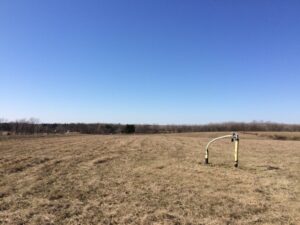
Photo 4. Top of the closed Belleville Landfill prior to solar array construction. Note landfill gas collection infrastructure in foreground.
Currently, closed landfills are especially popular solar sites. Whether for community solar, municipal utility power generation, or private development and power injection to the grid, landfills are being redeveloped as brightfields across the U.S. While challenging, seeing a completed solar plant on an otherwise underutilized open space is satisfying.
TRC has supported the development of many solar-on-landfill projects, including the recently commissioned AES Belleville Solar located on a closed landfill in western Illinois—just outside of St. Louis, Missouri—and developed by AES Clean Energy.
The AES Belleville solar project was one of the first to coordinate with the Illinois Environmental Protection Agency (IEPA) to determine the proper landfill post-closure permit modification process and allow a solar PV electrical generation plant to be constructed on a permitted landfill.
The key to a successful development is designing and building the array such that it does not compromise the closed landfill cover system or do anything that comprises the landfill’s integrity. The solar array design must account for and avoid landfill appurtenances, such as landfill gas and leachate extraction wells, plus provide truck-accessible routes to these features for maintenance and repair purposes.
The site design process included a thorough geotechnical engineering evaluation to verify the load bearing capacity of the landfill’s specific cap construction, as well as the use of low-load-bearing equipment and oversized equipment pads to minimize the pound per square inch impact of any vehicles and infrastructure.
Landfill solar arrays almost always use ballasted racking systems and cable trays as the landfill caps cannot be penetrated or otherwise compromised.
A quality assurance program both during design and construction ensures the cap integrity is maintained. It is imperative to re-establish the grass cover as soon as practicable to minimize erosion of the soil covering the landfill and to prevent problems.
The AES Belleville Solar project is an example of a successful brightfield development and is one of the biggest solar-on-landfill developments in the country. The 10 MW array covers almost 80 acres of the landfill cover system and allows for regular landfill monitoring.
The power plant is now generating not only affordable electricity, but also tax payments to the local municipal authority.
The Incentive Advantage
One potential advantage of developing renewable energy on Brownfields we have yet to mention is the possible availability and use of incentives targeted at the redevelopment of these properties to promote their use in lieu of greenfield land.
One of the obvious first challenges for brightfields is cost; specifically, who is going to pay what can amount to hundreds of thousands of dollars in environmental cleanup and compliance.
Public-private-partnerships (P3) can use a variety of financial mechanisms to support development and manage the costs of environmental conditions that are above and beyond the solar plant’s capital expense. This financial assistance can come in the form of grants, loans, and tax increment financing (TIF).
The Brownfields Utilization, Investment, and Local Development section of the Better Utilization of Investments, Leading to Development (BUILD) Act of 2018 omnibus provides just such potential availability and use of Brownfield funding for renewable energy development (Big wins for renewable energy in the Build Back Better bill.).
Individual States also promote the use of Brownfields for renewable energy. Rhode Island, for example, has incentives for developing solar-on-brownfields. Access to these types of P3 funding mechanisms can be the difference between the successful repurposing of an otherwise unused property and the loss of tax dollars to the community because costs pushed a project down the road.
Brightfields are Here to Stay
Redevelopment of brownfields to brightfields brings its own sense of accomplishment. The environmental and energy outcomes are better for the community. Not all renewable energy developers have the tolerance for the added costs and regulatory involvement required to convert a brownfield to a brightfield, and local communities must be just as committed. For those that do, the positive impacts to urban areas including blight removal, productive re-use, and environmental justice can be immeasurable.
About the Authors
 Doug Kilmer is TRC’s Vice President of Renewables Resources and Hydrogen with 30 years of environmental, brownfield and energy consulting experience.
Doug Kilmer is TRC’s Vice President of Renewables Resources and Hydrogen with 30 years of environmental, brownfield and energy consulting experience.
He has supported the development, construction, and commissioning of more than 4 GW of renewable energy generation and storage.
One of Doug’s specialties is the redevelopment of brownfields into brightfields.
 Paula Lancaster is a Senior Director of Development for AC Power, LLC with parallel focuses on business development and project development in the Midwest and Mid-Atlantic regions of the US.
Paula Lancaster is a Senior Director of Development for AC Power, LLC with parallel focuses on business development and project development in the Midwest and Mid-Atlantic regions of the US.
Paula brings with her expertise in professional environmental consulting, having coordinated the efforts of multidisciplinary teams performing environmental, permitting, and design services supporting solar photovoltaic development primarily in the Midwest.
She also has a background in environmental due diligence and remediation of urban blighted properties.


